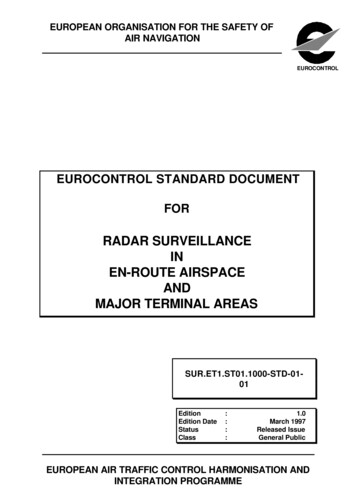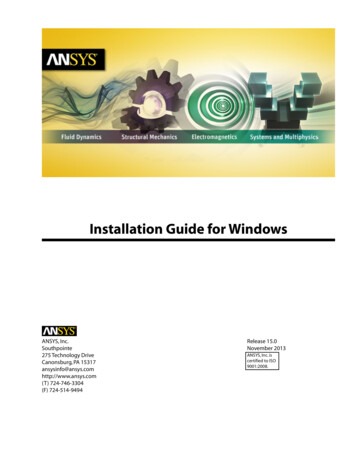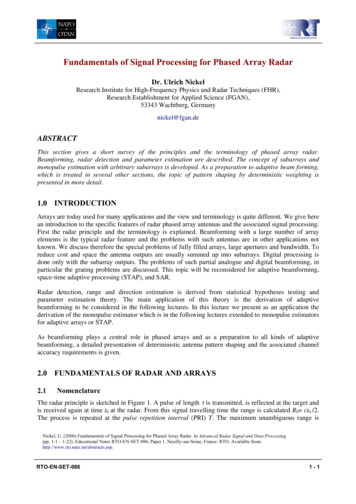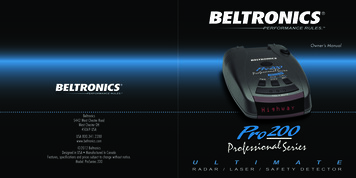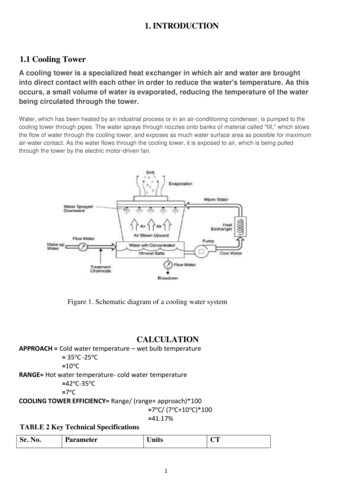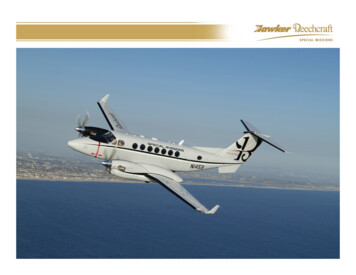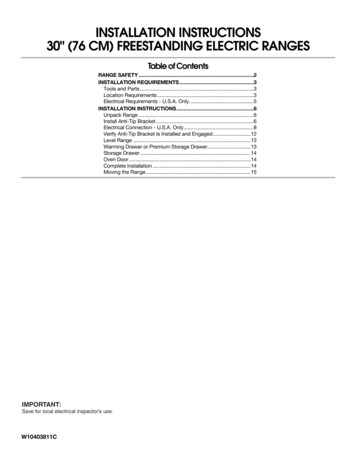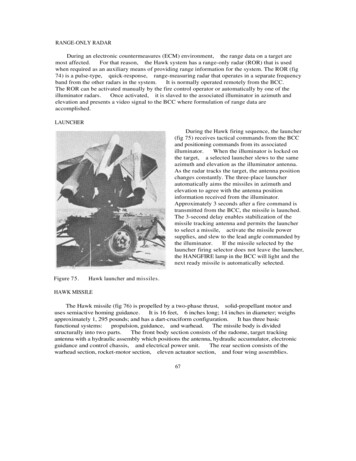
Transcription
RANGE-ONLY RADARDuring an electronic countermeasures (ECM) environment, the range data on a target aremost affected.For that reason, the Hawk system has a range-only radar (ROR) that is usedwhen required as an auxiliary means of providing range information for the system. The ROR (fig74) is a pulse-type, quick-response, range-measuring radar that operates in a separate frequencyband from the other radars in the system.It is normally operated remotely from the BCC.The ROR can be activated manually by the fire control operator or automatically by one of theilluminator radars.Once activated, it is slaved to the associated illuminator in azimuth andelevation and presents a video signal to the BCC where formulation of range data areaccomplished.LAUNCHERDuring the Hawk firing sequence, the launcher(fig 75) receives tactical commands from the BCCand positioning commands from its associatedilluminator.When the illuminator is locked onthe target, a selected launcher slews to the sameazimuth and elevation as the illuminator antenna.As the radar tracks the target, the antenna positionchanges constantly. The three-place launcherautomatically aims the missiles in azimuth andelevation to agree with the antenna positioninformation received from the illuminator.Approximately 3 seconds after a fire command istransmitted from the BCC, the missile is launched.The 3-second delay enables stabilization of themissile tracking antenna and permits the launcherto select a missile, activate the missile powersupplies, and slew to the lead angle commanded bythe illuminator.If the missile selected by thelauncher firing selector does not leave the launcher,the HANGFIRE lamp in the BCC will light and thenext ready missile is automatically selected.Figure 75.Hawk launcher and missiles.HAWK MISSILEThe Hawk missile (fig 76) is propelled by a two-phase thrust, solid-propellant motor anduses semiactive homing guidance.It is 16 feet, 6 inches long; 14 inches in diameter; weighsapproximately 1, 295 pounds; and has a dart-cruciform configuration.It has three basicfunctional systems:propulsion, guidance, and warhead.The missile body is dividedstructurally into two parts.The front body section consists of the radome, target trackingantenna with a hydraulic assembly which positions the antenna, hydraulic accumulator, electronicguidance and control chassis, and electrical power unit.The rear section consists of thewarhead section, rocket-motor section, eleven actuator section, and four wing assemblies.67
Figure 76.Hawk missile.Initial thrust to boost the missile to operational speed and sustaining thrust to maintain thatspeed are provided by the propulsion system.The guidance system uses energy reflected fromthe target to continually compute a collision course.The warhead system explodes the missilewarhead at the optimum point to insure target kill.For safety purposes, a destruction systemis provided to destroy the missile in flight if required.PALLETHawk guided missile pallets are used for storing and transporting ready missiles.Thepallet, which may be mounted on a 2-ton, two-wheel trailer (fig 77), consists of three missilesupport arms and two index fittings connected to the skid.The missile support arms arecontoured to the shape of the missile, each arm having a forward and rear missile latch to secure amissile.The index fittings are provided to position the loader properly for the transfer ofmissiles to or from the pallet.A pallet with three missiles can be transported by helicopterwhen the trailer is detached.Figure 77.trailer.Hawk pallet mounted on 2-tonFigure 78.Loader-transporter transferring missiles to launcher.68
LOADER-TRANSPORTERThe lightweight loader-transporter is a full-track, self-propelled vehicle used to transferfrom one to three missiles between the pallet and launcher (fig 78).When rigged as a crane,a secondary function of the loader-transporter is to pick up and transfer individual missiles andmissile components.During movement of the battery, the three loader-transporters (organicto the battery) are carried in the cargo beds of extra-long-wheelbase 2 -ton trucks.ASSAULT FIRE UNITFor special operations,such as helicopterborne (fig 79) and amphibious assaults (fig 80), aportion of the Hawk missile battery can be detached and used as an assault fire unit (AFU). Thisenables the battery to move by echelon and still remain operational during the move.Figure 79.Hawk unit in helicopterborne operation.The assault fire command console (AFCC) (fig 81) is the fire control central for the AFU and iscapable of remote control of the AFU or the augmented assault fire unit (AAFU).The AFUconsists of one AFCC, one illuminator, one launcher, one pallet with three missiles, oneloader-transporter, one crew chief junction box, and the necessary power equipment. The AFU maybe augmented by the addition of one CWAR and up to two more launchers with additional palletsand missiles.Equipment may be added until the complete Hawk battery is emplaced.Whenthe full battery is emplaced, control of the unit is changed from the AFCC to the BCC.Indicatorsare provided on the AFCC (fig 82) for display of equipment status and other information necessaryfor tactical control of the AFU or AAFU.69
Figure 80.Figure 81.Hawk in amphibious assault.Scheme of operation, AFU and AAFU.70
When the AFU is used, the illuminator operatesin a predetermined search pattern for a given sector,as determined by the tactical situation.Asatarget enters the radar search pattern, the illuminatorwill automatically lock on and track it.After lockhas occurred, the operator evaluates the indicationspresented and insures that the desired target is beingtracked.The launcher is slaved to the azimuthand elevation of the illuminator, thereby aiming itsmissiles directly at the target.When the target iswithin range, the AFCC operator electronicallyissues a missile fire order.The sequence ofevents after the fire order is initiated is identical tothe sequence when using the BCC.When the AAFU is used, targets are primarilydetected by the CWAR and displayed on a radarscreen at the AFCC.Additional search capabilitycan be obtained by causing the illuminator to searchin a predetermined pattern.When a target isdetected, the AFCC operator will remotely positionthe illuminator to the azimuth of the target and theFigure 82.Assault fire command console. radar will search for and lock on the target.Afterlock indications are received, the operator insuresthat the correct target is being tracked and then selects a launcher from which missiles will befired.The subsequent sequence of events is identical to that used when the AFU is employed.HAWK ANTIMISSILE CAPABILITYThe Hawk system has demonstrated its accuracy and reliability by successful engagementsagainst Honest John (fig 83), Little John (fig 84), and Corporal (fig 85) missiles. Addition of thehigh-power illuminator radar has increased system effectiveness against targets having smallradar cross sections.EMPLOYMENTThe primary employment guideline for Hawk units is to position the fire units well forwardalong the low-altitude routes of approach to effect enemy target destruction prior to release ofweapons, regardless of the delivery technique employed.Hawk units providing AD for vital areadefense and priority targets within the field army likewise would be located well forward along thelow-altitude routes of approach into the area.Units should be placed no closer to the forwardedge of the battle area (FEBA) than 10 kilometers.71
Figure 83.Hawkdestroys HonestJohn.Figure 84.Hawkdestroys Little John.Figure 85.Hawkdestroys Corporal.72
GUIDED MISSILE SYSTEM RADAR SIMULATOR STATION (AN/TPQ-21)Until the recent development of the AN/TPQ-21, the Hawk unit commander had insufficientmeans at his disposal for adequate realistic training of on-site radar operators.To train Hawkbattery control central (BCC) operators, it was necessary to obtain high-performance aircraftequipped with electronic countermeasure emitters.In CONUS, the cost and availability ofaircraft and the Federal Aviation Agency's control of flight patterns and the use ofelectromagnetic emanations all contributed to a reduction of training effectiveness.In overseaforward areas, tactical aircraft have difficulty in simulating hostile actions and emitting ECMwithout providing the enemy with information of an intelligence nature. This situation has beenimproved considerably by use of the AN/TPQ-21 (fig 86), which will be issued to Hawk units inthe near future.Figure 86.AN/TPQ-21 (cutaway view).When connected to the Hawk system, this simulator provides an artificial tacticalenvironment for the training of operators.No change in operation of the BCC is apparent to theoperators when using the AN/TPQ-21 for target engagement.With the technique of insertingvideo, doppler, and other simulated effects, the ECCM features of the Hawk radars are used andthe operator can be evaluated as to his ability to counter ECM.The AN/TPQ-21 is inclosed in a Craig shelter similar to the battery control central and hasthe same transportability feature (helicopter, cargo aircraft, or truck).It is capable ofsimulating six airborne targets, each independently maneuverable against the Hawk battery.Simulated targets can emit ECM if so programed.Targets may be designated as hostile orfriendly, and the size can be varied to produce returns of any desired cross section from 1 to 25square meters.The simulator also can produce complete launcher effects, AADCP symbology, radarground clutter, IFF, and simulated responses from the five radars of the Hawk battery.73
A quick-disconnect feature permits the simulator to be electrically switched in or out of theHawk functional system in a few seconds, thus the change from a training status to combatreadiness can be done immediately.AIR DEFENSE ARTILLERY AUTOMATIC WEAPONS EMPLOYMENTSince the end of hostilities in Korea, tactical doctrines have been revised and refined in thelight of combat experiences and the improved capabilities of the materiel available for airdefense.Also, the reorganization of the Army divisions imposed new requirements on AADunits.This reorganization has increased the problem of providing a workable AD for widelydispersed forward elements of the field army.These divisions require strong and effectiveAD if they are to live and fight from day to day.ADA, now more than ever, must provide theactive air defense of units in the forward areas to afford protection against air attack.Much of the air defense of forward areas presumably will be furnished by missile systems;however, it may be expected that terrain features will result in air corridors below the radarhorizon.This lack of AD radar coverage of the division front will provide the enemy withairspace in which to achieve surprise and in which aggressive air attacks may persist.Theseair corridors will be virtually uncontested avenues of approach, not only endangering forwardarea units, but AD and other support units as well.To fill this missile gap at low altitudes and in the forward areas of the battlefield, ADautomatic weapons (AW) units will form a definite part of the AD. Gun-type ADA weapons willnot only provide the division a defense against attack aircraft and airmobile forces but alsopossess a secondary capability of attacking point surface targets, a capability welldemonstrated during World War II and in Korea.Aircraft must not be permitted to cross the forward edge of the battle area (FEBA)unobserved; therefore, the primary employment guideline for AW weapons is to position the fireunits well forward along the low-altitude routes of approach that are not effectively covered byother AD systems.The Army is currently testing other gun systems with improved capabilities to replace orto complement the M42.These advanced guns are rapid firing, multiple-barrel systems thatare highly accurate and possess a high degree of mobility.TWIN 40-MM GUN M42The self-propelled, full-tracked, twin 40-mm gun M42 is an armored AD weapon.Thisvehicle (fig 87) was designed for employment with divisions for air defense; but because of itsrapid rate of fire, it has also proved a valuable support weapon against ground targets. It has acruising range of 100 miles at speeds up to 45 miles per hour, a fording depth of 40 inches, and aweight of 24 tons.74
Figure 87.Twin 40-mm guns M42.Major armament is the dual 40-mm automatic gun M2A1 mounted on the 40-mm gun mountM4E1.The 40-mm gun is a high-velocity, flat-trajectory, clip-fed, automatic-loading weaponcapable of firing 240 rounds per minute.The cyclic functioning of each gun is automatic fromthe firing of one round to the next.The welded armorplate gun mount is an open-topped cylinder in the center section of thevehicle.This mount is supported on a ball bearing race ring and can be traversed 360 ineither direction by power (9 seconds) or manually (10.3 per crank revolution). Crew positionsfor the squad leader, gunner, and two cannoneers are in the gun mount.Three sighting devices are incorporated into the fire control system:sight M38, reflex sight M24C, and speed ring sight.the computingThe computing sight M38 is designed to provide an effective means of controlling fire of the40-mm gun against either a vehicular or aerial target.The reflex sight M24C is designed to superimpose areticle pattern in the gunner's line of sight (fig 88) and isused in conjunction with the M38 computing sight duringpower operations .Figure 88.Reticle pattern,reflex sight M24C.The speed ring sight is used during manual operation ifa power failure or local control system malfunction occurs.It has a rear peep element and a series of concentric circlesas a front element.The communications system of the M42 gun consists ofradio set AN/VRC-9, radio receiving set AN/GRR-5, anintercommunications set, and interphones.Thisequipment is shock-mounted on support shelves in thedriving compartment.The AN/VRC-9 is used forintervehicular and command communication, and theAN/GRR-5 provides AD intelligence.75
The M13 periscope is used by the driver and commander while operating under combatconditions during daylight, and the M19 periscope, a binocular-type, enlarged view device, isused when driving the vehicle under blackout conditions.Infrared rays are projected forwardfrom the blackout headlights to illuminate the field of view.The M19 periscope converts theinfrared image to a visible image which is viewed through conventional eyepieces.ANTIAIR WARFARE WEAPONS OF THE U.S. NAVYIn fulfilling its antiair mission, the U.S. Navy employs missiles in both the surface-to-airand air-to-air roles. Some of the weapons available to NORAD for defense of the NorthAmerican Continent are discussed below.AIR-TO-AIR MISSILESSidewinder, which uses infrared passive homing (he at-seeking) guidance, was developed bythe Navy and is designed for use in attacks against jet aircraft.It is also used by the Air Forceand Marines.Against a mach 2 target at 60, 000 feet altitude, the missile has a range ofapproximately 4 miles.This solid-propellant missile is the first air-to-air missile to havedestroyed aircraft under actual combat conditions.It was successfully employed by ChineseNationalists in the defense of Quemoy in 1958. The Sidewinder (fig 89) is more than 9 feet long,weighs more than 155 pounds, and delivers a high-explosive warhead.Sidewinders are carried(fig 90) as armament in the F4D, F3D, F8, MF1C, F1C, and F11F aircraft.Figure 89.Figure 90.Sidewinder missile.Navy Skyray (t'lLJ) ali-weauier lighter with bicie winder.76
Sparrow III is the latest in this series of missiles.Its electronic homing guidance systempermits attack of high-performance aircraft from all aspects, including head-on.Anall-weather missile, its low-altitude capability, accuracy, and kill probability are excellent.Sparrow III is about 12 feet long and weighs about 400 pounds.This solid propellant missile,shown in figure 91 as it is fired from a Navy F3 Demon aircraft, attains a speed of 1, 500 miles perhour, has a ceiling of 60, 000 feet, and employs a high-explosive warhead.Sparrow is carriedaboard the Navy's all-weather fighters, the F3B Demon and F43 Phantom II.Figure 91.Sparrow III fired from Demon aircraft.SURFACE-TO-AIR MISSILESTerrier (fig 92) has been operational with the U.S. Fleet since 1956.It uses beam-riderguidance, is 13 inches in diameter, is about 27 feet long, and, with booster, weighs about 3, 000pounds.It has a range of 20 miles up to an altitude of 80, 000 feet and carries a high-explosiveor nuclear warhead.This missile is fired in a sequence that is automatic from selection of theready round in the magazine through launching; only seconds are required for the entire sequence.These missiles are currently operational on cruisers, destroyers, and a few carriers.Talos, a surface-to-air, beam-riding missile (fig 93), uses a solid fuel rocket motor for boostand a ramjet engine sustainer to attain a range of 100 miles.Talos is 30 inches in diameter, 32feet in length, and weighs 3, 000 pounds (more than 7, 000 pounds including booster).First firedat sea in 1959, the missile delivers a high-explosive or nuclear warhead at supersonic speed up to80, 000 feet altitude.77
Figure 92.Terrier missile batterieson U.S.S. Boston.Figure 93.Talos missile battery on guidedmissile cruiser, U.S.S. Galveston.Tartar (fig 94) is designed for use on destroyer-type ships of the fleet.It is effectiveagainst both low- and high-altitude targets and carries a high-explosive warhead to a range of 17miles and up to 65, 000 feet altitude.A dual-thrust, solid-propellant rocket accelerates themissile to supersonic velocity.Its overall length is about 12 feet and its diameter is slightlymore than 1 foot.Tartar is used as a secondary battery aboard Talos-equipped cruisers.Figure 94.Tartar missile fired from U.S.S. Norton Sound.78
AIR DEFENSE WEAPONS OF THE U.S. AIR FORCEAIR DEFENSE COMMAND INTERCEPTORSThe USAF Air Defense Command employs four types of all-weather interceptor aircraft plus avariety of air-to-air missiles to accomplish its mission and act as a deterrent AD force.The F-101B Voodoo (fig 95) can be employed in fighter and reconnaissance roles as well as aninterceptor.Produced in five models, the two-place F-101B is used as an interceptor, whilethe other models are used as both interceptor and reconnaissance aircraft.The F-101B candevelop a speed of mach 1.8 at 40, 000 feet with a ceiling of more than 50, 000 feet and a range ofover 1, 200 miles.This interceptor is armed with a combination of Genie air-to-air rocketsand Falcon air-to-air missiles.Figure 95.F-101B Voodoo.The F-102 Delta Dagger (fig 96) was the world's first supersonic all-weather jet interceptor andthe first to incorporate the area rule (coke bottle) fuselage design.Using all electronic equipment,the radar locks on the target and, at the right instant, the electronic fire control system automaticallyprepares and fires its weapon.Operational data show a supersonic speed with a ceiling of morethan 50, 000 feet and a range of more than 1, 000 miles.Main armament is a combination ofAIM-26 and AIM-4 Falcon missiles.Figure 96.F-102 Delta Dagger.79
The F-104 Starfighter (fig 97) is the most widely used fighter-interceptor in the free world airforces.Production for USAF has been completed, but variations of the F-104 are being builtunder the Military Assistance Program in Canada, Germany, Belgium, The Netherlands, Italy, andJapan.Greece and Turkey air forces also will use the F-104.The Starfighter versionemployed in the U.S. has a speed of more than 1, 400 miles per hour, a range of approximately 600miles, and a ceiling above 55, 000 feet.The F-104 is armed with Sidewinder missiles andVulcan 20-mm cannons.Figure 97.F-104 Starfighter.The F-106A Delta Dart (fig 98), evolved from the F-102 Delta Dagger and has a morepowerful engine; a redesigned tail, fuselage, and fuel tank; and improved electronics andarmament.The aircraft's electronic guidance and fire control system has the capability offlying the aircraft soon after takeoff through a cruise position to an attack position, detectingtargets, firing at optimum range, and immediately breaking off to seek other targets.At onetime, the F-106A held the world speed record at 1, 525.9 miles per hour. Its range is 1, 500 mileswith a ceiling of 50, 000 feet.The F-106A is armed with the Genie nuclear rocket and severalsuper-Falcon missiles.Many other jet aircraft, including the F-100, F-105, F4C, and F5A,can be used as fighters or interceptors; however, their prime mission is as fighters.Figure 98.F-106A Delta Dart.80
AIR-TO-AIR MISSILESThe primary armament of interceptor aircraft is air-to-air missiles.The Falcon family(fig 99) of air-to-air missiles are the smallest USAF guided missiles in production, having alength of approximately 6 feet, a diameter of about 6 inches, and a weight of about 100 pounds.Five basic versions of the Falcon have been produced.Some use radar-homing guidance; othersuse infrared homing.All have solid-propellant rocket motors.One later model has anuclear warhead.All of the missiles have supersonic velocity (mach 2, plus the speed of theaircraft), a ceiling above 50, 000 feet, and a range greater than 5 miles.AIM-26 (formerly GAR-11), an advanced version of the Falcon family, combines the nuclearcapability of Genie with AIM-4A accuracy.Carrying a small-yield nuclear warhead, itssemiactive radar guidance system enables low-altitude intercept.AIM-26 can be used on allF-102 aircraft.Figure 99.Falcon family of missiles (left to right): nuclear-capable AIM-26A, infraredAIM-4, radar homing AIM-4A, infrared AIM-4F, and radar homing AIM-4E .81
Genie (AIR-2A) (fig 100) is an air-to-air rocket that carries a nuclear warhead.It isunguided and uses a solid-propellant rocket motor.Genie is carried under the wing of the F-89Jinterceptor and in the missile bays of the F-101 and F-106.The missile has a length of 10 feet, adiameter of 17 inches, and a weight of approximately 800 pounds.The missile reachessupersonic velocity (mach 3, plus the speed of the aircraft) and can destroy targets at altitudesabove 50, 000 feet and at ranges of about 10 miles.Figure 100.Genie rocket being loaded on the F-106A Delta Dart.SURFACE-TO-AIR MISSILESBomarc is a missile that resembles an aircraft inconfiguration (fig 101) and uses a solid rocket boosterand two supersonic ramjet engines to develop speedsin excess of mach 2 and reach altitudes above 70, 000feet.It is guided from the ground to the vicinity ofthe target by commands from the SAGE system. As themissile approaches the target, a homing guidancesystem on the missile takes control and steers themissile to intercept.The nuclear warhead isdetonated by a proximity fuze. Bomarc has a wing spanof 18 feet, a length of about 57 feet, a height of 10feet, a weight of about 15, 000 pounds, and a rangein excess of 400 nautical miles.82Figure 101.firing.Bomarc missile at instant of
approximately 1, 295 pounds; and has a dart-cruciform configuration. It has three basic functional systems: propulsion, guidance, and warhead. . a secondary function of the loader-transporter is to pick up and transfer individual missiles and missile components. . radar will search for and lock on th
